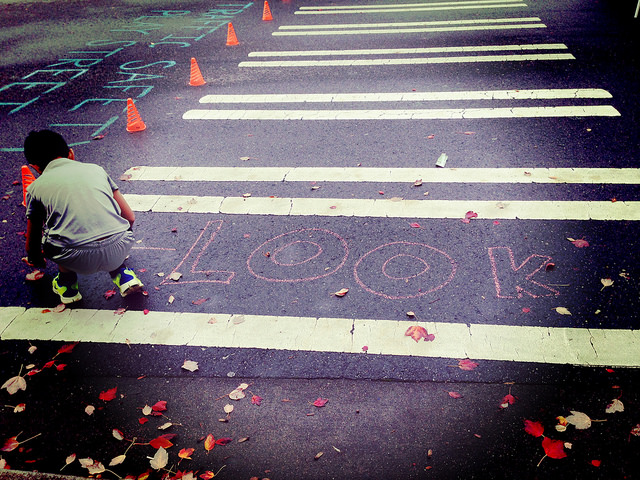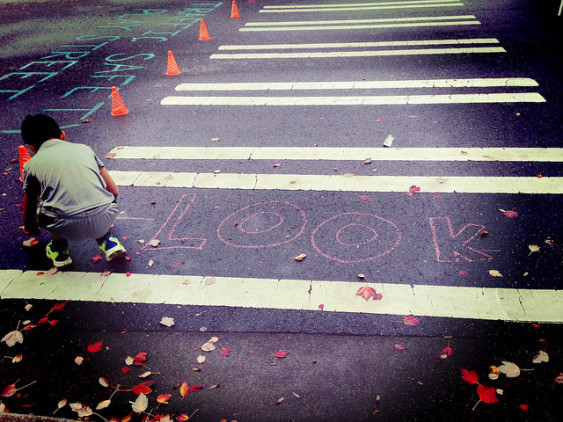Seattle became the second major Northwest city this week to promise to end all traffic deaths and serious injuries by embracing Vision Zero, a transportation approach that prioritizes keeping people alive and building streets that work for everyone.
The biggest changes for the next year are: Reduce downtown speed limits by 5 mph to 25 mph, improve 10 downtown intersections to benefit people walking, create slow “20 mph zones” in 5-10 neighborhoods where too many crashes happen, lower speeds on a dozen city arterials to 30 mph or below, improve the city’s most dangerous corridors, add 12 cameras to catch school zone speeders, add nearly 20 miles of safer bikeways, build 14 blocks of new sidewalks, and improve street crossings in 40 locations.
The city’s long-term goal is to eliminate all traffic deaths and serious injuries by 2030, in part by using data to drive investments and enforcement efforts to where they’re needed most.
“We should not accept death as a byproduct of commuting. It’s time to slow down to the speed of life.”—Seattle’s Vision Zero Plan
Vision Zero holds that people driving, people walking, people biking, people driving trucks, people using wheelchairs on our streets will all, from time to time, make mistakes. And that cities should design roadways so that those groups of people don’t come into conflict as often, and when they do, the consequences shouldn’t be fatal.
Seattle is actually one of the safest US cities, with a traffic fatality rate (3.2 per 100,000 people) rivaling Sweden’s (3 per 100,000), where Vision Zero was born. But city officials, who see the aftermath of downtown traffic fatalities from their office windows, acknowledged Thursday that Seattle ought to do better.
In recent months, a 7-year-old girl was hit in a crosswalk and left for dead, cars have plowed into a coffeeshop and hair salon, a 52-year-old man was killed in a crosswalk next to a library and preschool, and a new mom lost her life in a downtown bike lane. Even Seattle Mayor Ed Murray had a personal experience to share.
When he was 14, Murray was hit by a car while riding his bike in a neighborhood south of Seattle. He said the collision sent him to the hospital, left him unable to walk for six months, and had consequences that last to this day. While that’s not the main reason he wanted to pursue Vision Zero, Murray said, it illustrates the point:
If that car had been going 20 miles per hour, I would not have been thrown from my bike across someone’s yard. More importantly than me being injured, I remember the anguish my parents went through at the hospital week after week after week. This is what this is about. Twenty miles per hour can make a difference.
As the charts below show, between 150 and 300 people have been killed or seriously injured in recent years on Seattle’s roads, and people walking, people biking, and people on motorcycles fare worse in those collisions than people in cars. Traffic collisions are a leading cause of death for Seattle’s kids and young adults between ages 5 and 24. And people older than 50 have accounted for 70 percent of pedestrian fatalities in the last three years.

Image by City of Seattle, Vision Zero Plan
So here’s a closer look at how the city plans to get those numbers to zero. (For a map of all the following projects, see page 15 of the city’s Vision Zero plan.)
Downtown and Urban Center Changes

Around Seattle by SDOT photos used under CC BY-NC 2.0
Most pedestrian collisions happen in downtown Seattle, where more than 600 people walking have been hit by cars in the last three years. Collisions in the Central Business District have become more severe recently, largely due to speeding.
That’s why the city plans to lower speeds throughout downtown Seattle from 30 mph to 25 mph. As the graphic below shows, research has shown that speed has an enormous impact on the likelihood that a person on foot can survive a collision. Half of pedestrians who are hit by a car traveling 30 mph will die.

Image by City of Seattle, Vision Zero Plan
The Seattle Department of Transportation (SDOT) will start with James, Pike, and Pine streets and lower speeds throughout the rest of downtown by the end of the year. In part, that’s because the city needs time to adjust hundreds of downtown traffic signals and make other engineering changes to slow traffic. (For compaison, New York City just lowered speeds to 25 mph citywide.)
SDOT will also make safety improvements at 10 downtown intersections (along Fifth, Sixth, and Seventh avenues) with high crash histories. That includes outlawing right turns on red that create conflicts between cars and people crossing streets, giving people walking extra “lead time” to cross streets and become visible, and offering people biking and driving protected opportunities to turn.
Outside of downtown, the city will undertake similar intersection improvements and traffic calming in several urban centers where people walking, biking, driving, strolling, and riding transit all merge: Lake City at NE 125th Street and Lake City Way NE, White Center/Westwood at SW Roxbury Street and Delridge Way/16th Ave SW, and Columbia City and Hillman City on Rainier Ave S.
Citywide Changes

Image by City of Seattle, Vision Zero Plan
Because 90 percent of Seattle’s serious and fatal crashes occur on busy arterial streets, the city plans to review and lower speed limits to 30 mph or below (right now, they range from 20 mph to 40 mph) on city arterials.
In the next year, for instance, the Vision Zero plan commits to lowering speeds—by reducing limits, using radar speed signs, and making engineering changes—on a dozen corridors: Martin Luther King Jr Way S, Rainier Avenue S, 35th Avenue SW, SW Roxbury Street/Olson Place SW, Delridge Way SW, Fauntleroy Way SW, Harbor Avenue SW, Greenwood Avenue N, Holman Road NW, Seaview Ave NW, 5th Avenue NE, and 15th Avenue NE.
The city also hopes to reduce collisions on some of the most dangerous corridors through low-cost engineering, enforcement and education efforts, as well as make improvements for people walking, biking, and taking transit in others. SDOT will update crosswalk policies to emphasize the needs of older and younger residents, address safety problems around ubiquitous construction sites, and begin using more durable and reflective pavement markings across the city.

NE 40th Street protected bike lane by SDOT photos used under CC BY-NC 2.0
In 2015, SDOT also plans to follow through on commitments in the city’s Pedestrian and Bicycle Master plans by adding seven miles of protected bike lanes, 12 miles of neighborhood greenways, more than 40 crossing improvements, and 14 blocks of new sidewalks.
In 20 mph school zones where kids are walking or biking to school, the city will add twelve new cameras to catch speeders and use the revenue from tickets to improve infrastructure around schools.
Neighborhood 20mph Zones

Neighborhood greenways family by SDOT photos (license)
Although few fatal accidents occur on neighborhood streets, Vision Zero also aims to create communities where everyone—from unsteady toddlers to 6-year-old bikers to marathon runners to retired walkers—feels safe on the street. That’s why the city plans to implement five to 10 pilot “20 mph zones” in neighborhoods near parks and schools with a high crash history.
Similar projects have been wildly popular with New York City families and residents who want safer, traffic-calmed streets with speed humps, road narrowing, daylighting, and 20mph speed limits. Some want the city to take even more aggressive safety and engineering measures there.
To start, Seattle plans to install signs and pavement markings to clearly tell people driving that they’re in a slow zone and make sure intersections are cleared of obstructions that make it hard to see people in crosswalks.
Education and Enforcement
The other prongs of the Vision Zero plan include education—from rewarding people who follow street rules with gift cards to outreach campaigns to vulnerable groups like teen drivers and older pedestrians—as well as enforcement.
Seattle Police Department plans to incorporate traffic, speed, and collision data to identify areas with the highest enforcement needs, as well as to target risky behavior in high-crash areas. Officers will step up enforcement efforts in places where bicycle collisions frequently occur, as well as educate drivers about the consequences of failing to yield to pedestrians and “blocking the box” in crosswalks.
Seattle has also committed to publishing a Vision Zero report in October of each year, which will track the city’s progress toward achieving zero traffic fatalities and describe efforts for the upcoming year.
So how do the city’s initial efforts stack up? As the mom of a six-year-old, I’ll continue to argue that Seattle could lower speed limits on neighborhood streets to 20 mph citywide without inconveniencing many people (If you’re in that much of a hurry to get somewhere, you shouldn’t be on slower residential streets.) And I hope that’s where we’re headed, soon.
But Seattle’s Vision Zero plan is a reasonable and informed set of first steps. It focuses on the corridors, intersections, and areas where the data tells us things aren’t safe or acceptable. And it sets the city on a promising path to do something about that.
Let’s hope that the city continues its commitment to Vision Zero’s principles—that everyone has a right to be safe in traffic—by using that lens to prioritize projects and allocate funds in the next citywide transportation levy.










Rick Mohler
As a transit rider, pedestrian and recreational runner I fully endorse the proposal. However, without adequate enforcement it’s meaningless. SPD continues to issue jaywalking tickets but I’ve never seen them issue a ticket for a vehicular crosswalk violation.
Bob
Agreed Rick. I’ve yet to see someone walk or bike into a car with the result being fatal to the driver of the car. Let’s hold SPD accountable for issuing tickets to those who actually behave in ways that are legitimately hazardous to others.
RDPence
I hope SDOT thinks through this No Right On Red thing. It’s not a simple “this is always better” issue.
Banning those turns means higher volumes of traffic must flow with the green light. Traffic signals may need to be retimed to balance flows.
Right turns on red are only a ped issue for peds crossing perpendicular to the motor vehicle. Vehicles making a right turn cross a crosswalk that shows a WAIT light to peds.
I was at one of these No Right On Red intersections the other day, waiting to make a right turn. I could’ve easily turned right across an empty crosswalk, but didn’t in deference to the new restriction. But when I got my green light, the crosswalk was full of pedestrians and I couldn’t make the turn. When the crosswalk finally cleared, I was able to sneak through on the yellow.
Like I said, let’s think this through….
Chad N
One note about the comparison to Swedish traffic fatalities.
Sweden as a whole may have a traffic fatality rate of 3/100,000 people, same as Seattle, but the more relevant comparison is to Stockholm. Rural areas typically have more fatalities than cities due to higher travel speeds and auto dependence.
Stockholm has a fatality rate of 0.7/100,000 people, significantly lower than Seattle’s 3.2/100,000 (source: an LA Times article). That is the model we should learn from.